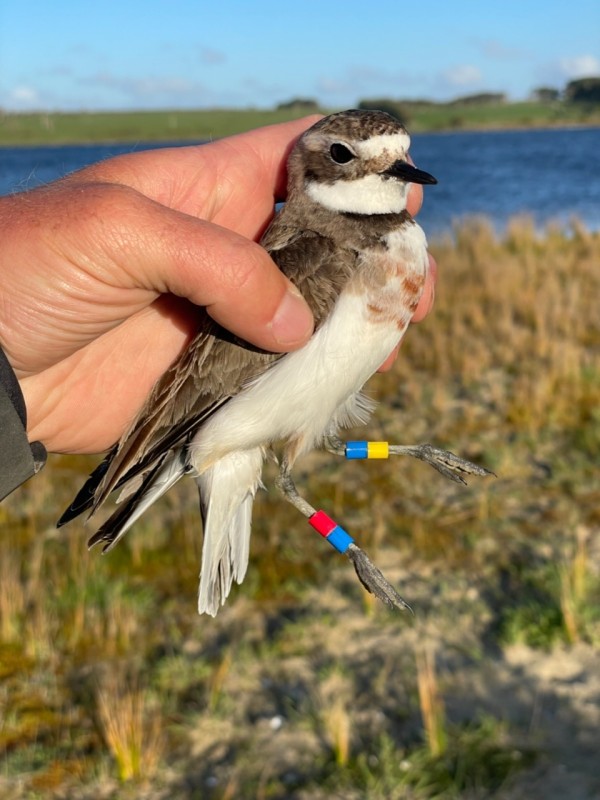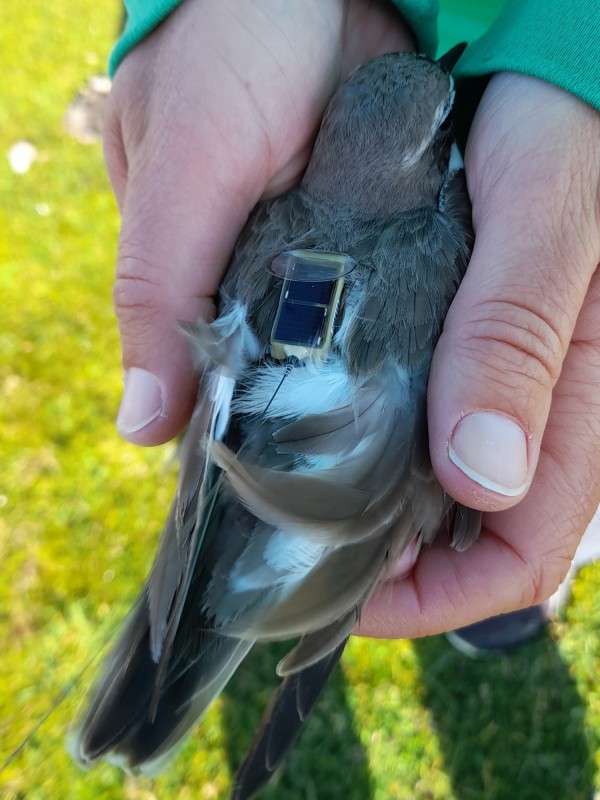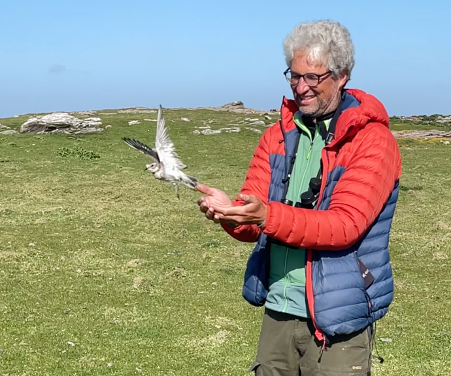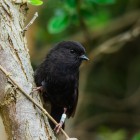Blog and news
Banding dotterels in the Chathams – the science
The Chatham Islands are home to a population of about 200-300 pohowera/banded dotterels – but very little is known about the species’ habits in this remote population. Last October, a team of researchers headed over to the Chathams as part of a nation-wide effort to learn more.
In late 2024, we started a project on pohowera/banded dotterels (Anarhynchus bicinctus) across New Zealand. We are a team of researchers specialising in studying shorebirds, led by Prof. Bart Kempenaers, head of the Department of Ornithology at the Max Planck Institute for Biological Intelligence in Seewiesen, Germany. Working in collaboration with the Fauna Science Team at the Department of Conservation (DOC) led by Emma Williams, we aim to understand the underlying factors shaping this shorebird’s curious migratory behaviour.

One of the colour banded Chatham Island banded dotterels. Image: Dave Bell
Why did we come all the way from Germany to study birds in New Zealand?
Well, part of our team are Kiwis – working in Germany, but we’ve chosen to study banded dotterels because its migratory behaviour is rather unique from a global perspective. This bird can also be conveniently studied across a wide range of breeding habitats throughout New Zealand – from the sandy shores of Southland to the dusty volcanic plateau of the Rangipo Desert, from the rocky terminus of the Tasman Glacier to the windswept shores of the Te Whanga Lagoon. Furthermore, our partnership with DOC gives the research an important applied benefit to the conservation of banded dotterels. They are Nationally Vulnerable and declining at an unsustainable rate of 3.7% per year.
Introduced predators, habitat loss and human disturbance are key threats known to endanger the survival of dotterels on their breeding grounds. However, the threats banded dotterels face at their nonbreeding sites and along their flyways (migratory routes connecting their seasonal sites) are poorly understood.
Identifying and understanding their movements will help DOC determine which threats need to be managed along flyways and nonbreeding sites. The information gained from this research will be directly applicable to the conservation concerns of banded dotterels and other native wildlife of the Chatham Islands and mainland New Zealand, including how adaptable their migratory movements are to climate change.

A transmitter fitted to one of the tracked birds. Image: Dave Bell
What makes banded dotterel migration unique?
Banded dotterels exhibit a unique migratory behaviour unrivalled anywhere else on the planet. Individuals breeding next to one another during the summer do remarkably different things in the winter: some are content remaining on their breeding grounds year-round, while others are inclined to move elsewhere within Aotearoa. Some prove to be intrepid travellers, flying across the Tasman Sea to spend the winter in Australia or even further afield in New Caledonia.
Why fly over an ocean when you can stay put with your neighbours? Fascinating, aye?!
Banded dotterels breed throughout a variety of habitats across the North and South Islands, as well as the Chatham Islands and the subantarctic Auckland Islands. Some breed at high elevation habitats in the Southern Alps and Central Otago, while others occupy braided river systems, but the majority dwell on beaches, which makes sense - they are a “shorebird” after all!
Tagging and sampling individual birds
Our team conducted fieldwork across the banded dotterel’s core breeding grounds of the South Island and the lower half of the North Island. We also visited the Chatham Islands over a five-day period to incorporate this uniquely isolated breeding population into the nation-wide initiative.
Our main objectives were to capture breeding individuals and assign a unique combination of coloured leg bands (or an alpha-numeric white leg flag) so that the public can participate in the research by identifying individuals in the field and contribute information about resightings of individuals moving throughout the species’ range.
Our team also collected a tiny blood sample from each bird, which will be used to understand the genetic consequences of the species’ diverse migratory strategy and the Chatham Island’s geographic isolation from the New Zealand mainland.
We captured birds either by placing a trap on the nest or with mist nets away from the nest – both safe and well-established methods for catching shorebirds. To understand how banded dotterels use national flyways and quantify individual variation in migratory schedules, we also deployed 98 satellite tags across four sites spanning the South Island and two satellite tags on the Chatham Islands.

Two satellite-tagged banded dotterels nesting at Okawa Point, male "H1" (top-left) and female "HK" (top-right). Both birds left Okawa Point and have moved between the mouth and north-east corner of the Te Whanga Lagoon. The satellite image shows these two birds’ tracking data on Chatham Island between October 2024 and January 2025.
Unlocking individual journeys with isotope signatures
Banded dotterels exhibit two feather moults per year. On their wintering grounds, about a month before breeding starts, they conduct a 'partial moult' when they grow their characteristic rufous and black chest bands. Immediately following the breeding season, they undergo a 'complete moult' whereby they replace all feathers and acquire their winter plumage.
The nutrients taken up during foraging have a unique chemical make-up known as a ‘stable isotope signature’. Depending on where a dotterel is during each of these moults, their feathers will exhibit a location-specific signature. When banded dotterels grow their feathers, the local stable isotope signature is transferred from the environment to the feather tissue. Our project aims to use this key to unlock the hidden journey of individual birds.
We sampled a single flight feather and breast feather from each individual we captured. If the stable isotope signature of the breast feather matches the flight feather, the bird most likely stayed put year-round. However, if the stable isotope signatures are different, the bird most likely migrated, because the feathers were grown in two different locations.
Feather analysis may become a valuable and cost-effective method to determine the migratory movements of banded dotterels and other species across New Zealand.

Bart Kempenaers releasing a banded dotterel. Image: Luke Eberhart-Hertel
Continuing the research
The research cooperation between the Max Planck Institute for Biological Intelligence and the Department of Conservation is planned to continue over the next five years, during which we will continue colour banding and resighting banded dotterels nationwide to fully understand what factors relate to an individual’s decision to stay locally year-round or migrate over the Tasman Sea, and what threats exist to the species persistence.
The second part of this blog, with an account of the field research in the Chathams, is coming soon.


